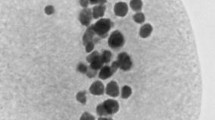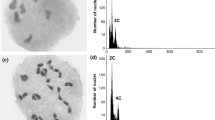Summary
New types of diploids in Brassica crops were synthesized after three consecutive selfing of aneuploids derived from backcrossing of sesquidiploids (2n=29, AAC) with B. campestris (2n=20, AA). The cytogenetic and morphological characteristics of plants with 2n=22, 24 and 40 in the S3 generation were analyzed in order to establish the extent in which these addition and polyploid lines were stabilized. A high frequency of 11II (79.7%), 12II (84.6%) and 20II (100%), were observed at metaphase I of pollen mother cells in 2n=22, 24 and 40 plants, respectively. The chromosome configuration at methaphase II also indicates that a certain level of stability has been attained cytogenetically. Although pollen stainability was relatively high, the seed set percentage was still low. Variation in morphological characteristics indicate the incorporation of one or more chromosome pairs from the C genome of B. oleracea. Other diagnostic characters such as the formation of determinate inflorescence, branching from the base of the stem, and the shift from self-incompatibility to self-compatibility must have resulted from the interaction between A and C genomes. Thus plants with 2n=22, 24 and 40 have been stabilized to some extent and can be developed into new breeding lines of Brassica. It is suggested that limited pollination could be effective in increasing the seed fertility of these plants.
Similar content being viewed by others
References
Akbar M.A., 1989. Resynthesis of Brassica napus aiming for improved earliness and carried out by different approaches. Hereditas 111: 239–246.
Avivi L., 1976. The effect of genes controlling different degrees of homoeologous pairing on quadrivalent frequency in induced autotetraploid lines of Triticum longissimum. Can. J. Genet. Cytol. 18: 357–364.
Buchholz J.T. & A.F. Blakeslee, 1930. Pollen tube growth and control of gametophytic selection in cocklebur, a 25-chromosome datura. Bot. Gaz. 90: 366–383.
Dawson C.D.R., 1941. Tetrasomic inheritance in Lotus corniculatus L. J. Genet. 42: 49–72.
Fukushima E. & S. Tokumasu, 1957. On the occurrence of aneuploidy in the offspring of the artificially induced auto-tetraploid plants in Japanese radish (Raphanus sativus L.) and Chinese cabbage (Brassica pekinensis Rupr.). J. Fac. Agr. Kyushu Univ. 11: 1–23.
Kondo Y. & K. Kariya, 1937. On the regression of the polyploid forms to the diploid condition in Oryza sativa L. Agric. and Hort. 22: 557–567 (In Japanese with English summary).
Lee K.H. & H. Namai, 1992a. Pollen fertility and seed set percentage after backcrossing of sesquidiploids (AAC genomes) derived from interspecific hybrid between Brassica campestris L. (AA) and B. oleracea L. (CC) and frequency distribution of aneuploids in the progenies. Japan. J. Breed. 42: 43–53.
Lee K.H. & H. Namai, 1992b. Stabilization of new types of diploids (2n=22, 24) through selfing of aneuploids (2n=21, 22) derived from crossing of sesquidiploids (2n=29, AAC) and Brassica campestris (2n=20, AA). Euphytica 60: 1–13.
McGrath J.M. & C.F. Quiros, 1990. Generation of alien chromosome addition lines from synthetic Brassica napus: morphology, cytology, fertility and chromosome transmission. Genome 33: 374–383.
McGrath J.M., C.F. Quiros, J.J. Harada & B.S. Landry, 1990. Identification of Brassica oleracea monosomic alien chromosome addition lines with molecular markers reveals extensive gene duplication. Mol. Gen. Genet. 223: 198–204.
Mizushima U., 1950. On several artificial allopolyploids obtained in the tribe Brassiceae of Cruciferae. Tohoku J. Agric. Res. 1: 15–27.
Namai H., 1976. Cytogenetic and breeding studies on transfer of economic characters by means of interspecific and intergeneric crossing in the tribe Brassiceae of Cruciferae. Mem. Fac. Agr., Tokyo Univ. Education 22: 101–171 (In Japanese with English summary).
Namai H., 1987. Inducing cytogenetical alterations by means of interspecific and intergeneric hybridization in Brassica crops. Gamma Field Symp. 26: 41–87.
Namai H., K.H. Lee & J. Toyama, 1991. Increase of male transmission rate of cabbage chromosome by limited pollination in alien chromosome addition lines of Chinese cabbage with single cabbage chromosome. Japan. J. Breed. 41: 655–659.
Namai H. & R. Ohsawa, 1988. Possibility of expanding genetic variation by limited pollination based on the reproductive success rate (RSR) of pollen grains deposited on stigma. p. 63–68. In: M. Cresti et al. (Eds). Sexual Reproduction in Higher Plants. Springer-Verlag, Berlin.
Namai H., M. Sarashima & T. Hosoda, 1980. Interspecific and intergeneric hybridization breeding in Japan. p. 191–203. In: S. Tsunoda et al. (Eds). Brassica Crops and Wild Allies: Biology and breeding. Japan Sci. Soc. Press, Tokyo.
Noguchi Y., 1950. On the diploid gigas-type selected in the progeny of tetraploid sunflowers. Ikushu-Kenkyu 4: 105–112 (In Japanese with English summary).
Nwankiti O., 1971. Cytogenetic and breeding studies with Brassica II. Progenies from backcrosses involving primary hybrids between B. napus and B. campestris. Hereditas 68: 35–46.
Quiros C.F., O. Ochoa, S.F. Kianian & D. Douches, 1987: Analysis of the Brassica oleracea genome by the generation of B. campestris-oleracea chromosome addition lines: characterization by isozymes and rDNA genes. Theor. Appl. Genet. 74: 758–766.
Sarashima M., 1976. Studies on the breeding of artificially synthesized forage rape (Brassica napus ssp. oleifera) by means of interspecific crosses between B. campestris and B. oleracea. Special Bull. Coll. Agr., Utsunomiya Univ. 29: 1–117 (In Japanese with English summary).
Shimizu, S., K. Kanazawa & T. Kobayashi, 1962. Studies on the breeding of Chinese cabbage for resistance to soft rot. III. The breeding of the resistant variety ‘Hiratsuka no. 1’ by interspecific crossing. Bull. Hort. Res. Sta., Japan, Ser. A1: 157–174 (In Japanese with English summary).
Takada M., 1986. Studies on the breeding of artificially synthesized Brassica napus ‘Hakuran’ with head formation habit and the establishment of cropping systems of F1 hybrids. Gifu Agr. Res. Center, Gifu. pp. 185. (In Japanese with English summary).
Author information
Authors and Affiliations
Rights and permissions
About this article
Cite this article
Lee, K.H., Namai, H. Cytogenetic and morphological characteristics of new types of diploids (2n=22, 24, 40) derived from consecutive selfing of aneuploids in brassica crops. Euphytica 72, 15–22 (1993). https://doi.org/10.1007/BF00023768
Received:
Accepted:
Issue Date:
DOI: https://doi.org/10.1007/BF00023768




